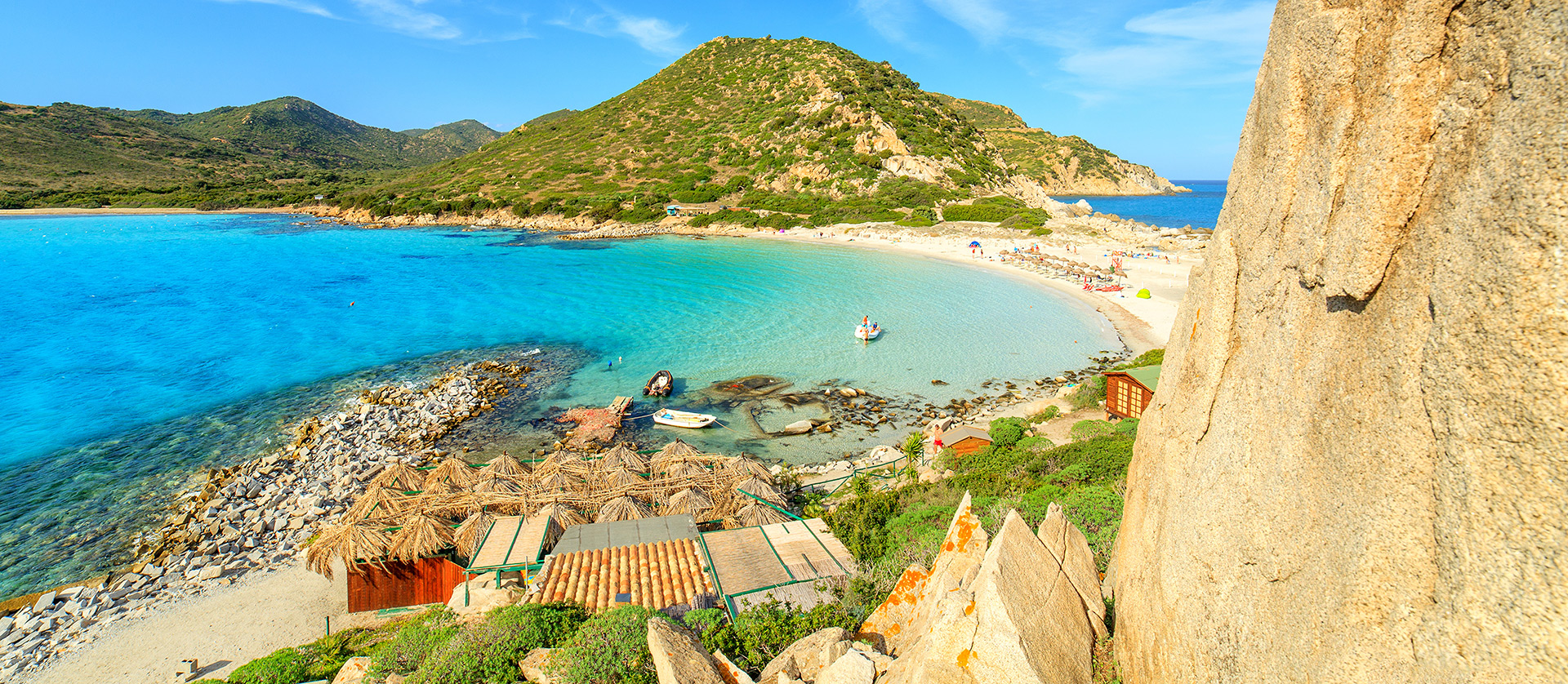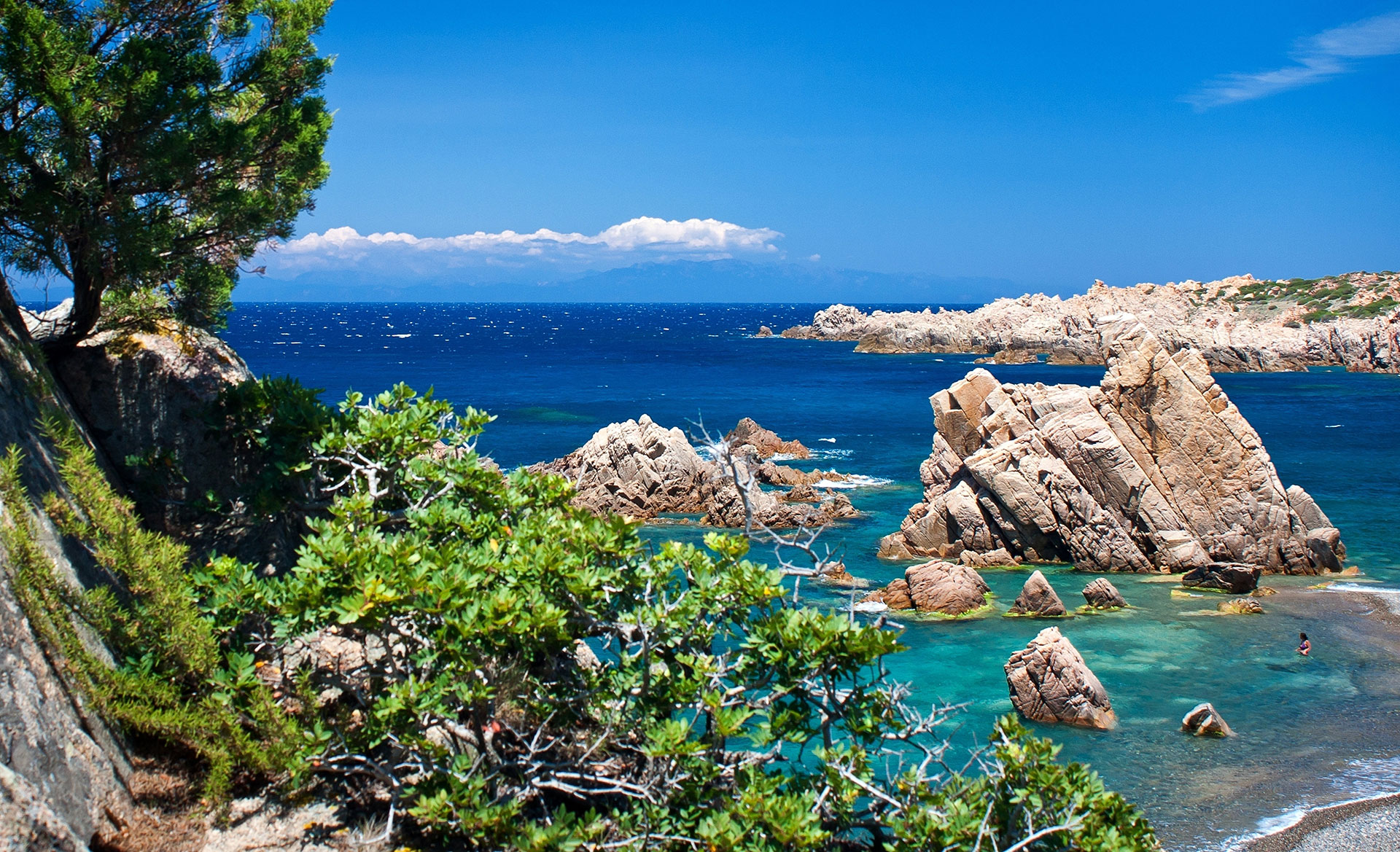Sardinia is a pearl of the Mediterranean. The island offers the combination of excellent holiday and the fabulous nature.
Sardinia is the second largest Italian island after Sicily among the islands of the western Mediterranean. It lies some 200km off the west of Italy. At its northern tip it gazes just a few miles across the water to the French island of Corsica, and 200 km north of the coast of Africa. The total area of the island is 24.000 km2. At length, 270 km and in width, 120 km. The relief of the island is dominated by mountains. The highest point of Mount is La Marmora 1834 m in the rock mass Dzhenardzhentu. The most important rivers of the island are Tirso, Koginas and Flyumendoza and used for electricity generation and irrigation. Rivers of Sardinia are not large and have many rapids.

Sardinia is an autonomous region of Italy. The island is divided into 7 provinces. Major Cities of Sardinia are Sassari, Olbia, Alghero, Nuoro, Oristano, Porto Torres. The island’s capital and the main port is the city of Cagliari.
Sandalis was named the island by the ancient Greeks, and really the shape of the island resembles a sandal. In the one of legends confirmed that it is here the God set foot in the primordial ocean, when first came down to Earth. Since the trace stayed in the sea.
There is another legend which says that the name of the island came from Sardus, son of Hercules, who conquered the island in prehistoric times.
The population of Sardinia is more than 1.6 million people. The peoples who inhabited this island before, left their sign, their culture. Most of the residents speak in Italian language. The part of the population uses the different dialects. Thanks to isolation from the continent Sardinia was able to preserve its characteristic traditions, numbering hundreds of years. The inhabitants of Sardinia are hospitable and friendly to foreigners which is a destinctive code of honor. The life on the island is slow and a little old-fashioned. Here shepherds walk with their herds in the mountains and in every village you can see traditional costumes, and to touch original traditions. Folklore and crafts are flourishing on the island. Every town and village have annual festivals which demonstrate the art of riding, delicately embroidered costumes, singing and dancing accompanied by a triple clarinet. Traditionally, Sardinia has an excellent cuisine, pleasing to taste unique wines, bread, homemade pasta, cheeses, meats.
The level of crime on the island is one of the lowest in Italy.

Undoubtedly, the most attractive for tourists on the island are a beuty of Sardinia, a wonderful sea and a huge number of beaches. As if indeed the God awarded the island of fascinating places and beautiful clear sea when down here for the first time. At the first look the island attracts with its harmony of nature, climate, and rhythms of the life philosophy. And it all merges into one beautiful whole.
If it were a perfect planet, it would be called Sardinia! There are many archaeological and natural reserves on the island. Flamingos nest here during the African off-season.
The seas surrounding Sardinia are clean and transparent, and transmit all colors from blue to green, combining the most unusual colors. It is considered the most pure and transparent sea in Italy.
And the amazing beaches! They constitute 1850 km. This is a quarter of beaches in Italy, the best quarter! Here still remained completely untouched by civilization corners of paradise with white, gold and pink beaches, secluded rocky bays, picturesque lagoons where nest flamingos. White beaches bordered with a huge black rock juts extremely picturesque and considered the most beautiful in Italy. And not far away was built modern hotels with first class service and develop infrastructure. Hospitality of hotels with the service at the highest international standards brought the fame to Sardinia as a place for luxury holidays.

Sardinia there is infinte of horizons, the ridge of rough rocks, hills of granite, basalt and limestone; mountains covered with dense thickets of wild, smooth of bogs, and wind blow archipelagos. The island immersed in the greenery of palms, pines, olive and lemon gardens, beautiful meadows and groves of oak and cork. A large part of Sardinia covered by xerophitic bushes, prickly pear and myrtle. Wherever you look you can see a firework of flowers: bright crimson bougainvilles, scarlet ibiscuses and the fragrance of myrtle and mastic trees. And therefore it is no mere chance that Sardinia called the island of hundred flowers and hundred smells.
On the island the climate is extremely mild, subtropical and Mediterranean. There are a low precipitations during the summer period. The mojority of precipitations fall in the winter from 600mm in the plains to 1000mm in the moutains. Here you can enjoy the sunshine 300 days in a year. The average temperature in January is 7-10C, July-24-26C. In Sardinia the water of the seashore heats up to 23-25 C in the summer.
The season begins in Sardinia in April. The peak of season falls in August. For persons who prefer to have a quiet holidays more better to visit Sardinia in May, June and September when have not so many lively high life parties and prices are more democratic.
 Sightseeings
Sightseeings
Geographically the island was located at the crossroads of many civilizations. So today Sardinia is surprising with wealth of architecture monuments. The ancient history has left its traces at the all island. There are remains of Phoenician necropolises, Roman amphitheatres and fortresess of Genoa and Pisa, Romanesque churches and Gothic cathedrales. As long ago, as ancient times local peaple possessed the secrets of metalworking and constructed buildings for ages. Therefore up to now after millenium modern tourists have the possibility to enjoy of majestic buildings that centuries did not have a power.
Nuraghes are the most amazing monuments of architecture which you will never see. These castels and watchtowers were built with gigantic blocks of basalt from extinct volcanos. The most part of nuraghes are small sized, but remained so buildings rappresenting towers as residential buildings, tombs and forts. Nuraghes of Sardinia were standing more than 25 centuries. Now they kept more than 7000.
One of the graet number of archeological sites are the Domus de Janus that a symbol of mourning rituals and Meniers that rappresenting sacred stones which a symol of transition from the world of living to the world of dead.
In Sardinia remained a lot of monuments of peoples who inhabited the island. These are beautiful ruins of Phoenician cities as Nora, Karalis, Tarros, Sulcis so settlements of Romans, Carthaginians, Pisan, Genoase, Arabs, Byzantines, Spaniards. Medieval cities are interesting and charming as Alghero surrounded by a fortifired wall with seven towers, Cagliari with cathedral and early Christian church so Olbia that a ancient Roman port connected Sardinia and Ostia.
The most part of hotels in Sardinia were built with a respect of the nature landscape. These are one or two-storeyed cottages and villas.
The main attraction of the island is undoubtedly its beaches. Tourists impress, amaze and fascinate some places, regions and cities with a splendid scenery unique in their colors, comfortable beaches, architecture, centuries-old traditions and other sightseeings in all parts of the island.


